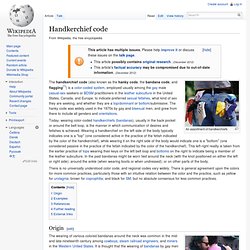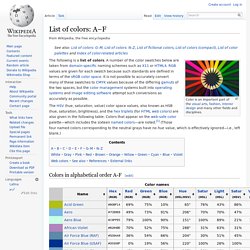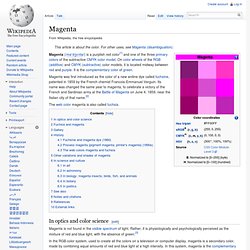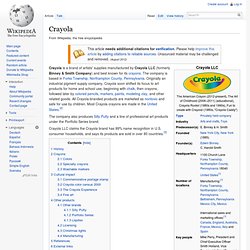

Online Etymology Dictionary. Online Etymology Dictionary. Handkerchief code. An assortment of handkerchiefs Today, wearing color-coded handkerchiefs (bandanas), usually in the back pocket or around the belt loop, is the manner in which communication of desires and fetishes is achieved.

Wearing a handkerchief on the left side of the body typically indicates one is a "top" (one considered active in the practice of the fetish indicated by the color of the handkerchief), while wearing it on the right side of the body would indicate one is a "bottom" (one considered passive in the practice of the fetish indicated by the color of the handkerchief). This left-right reality is taken from the earlier practice of tops wearing their keys on the left belt loop and bottoms on the right to indicate being a member of the leather subculture.
Cyan. Cyan (/ˈsaɪ.ən/[4] or /ˈsaɪ.æn/[5]) is a greenish blue color[6] and one of the three primary colors of the subtractive CMYK color model.[7] On the color wheels of the RGB (additive) and CMYK (subtractive) color models, it is located midway between blue and green, making it the complementary color of red.

Its name is derived from the Ancient Greek κυανός, transliterated kýanos, meaning "dark blue".[8][9] It was formerly known as "cyan blue"[10] or cyan-blue[11] and its first recorded use of as a color name in English was in 1879.[12] Further origins of the color name can be traced back to a dye produced from the cornflower (Centaurea cyanus).[13][14] In the CMYK color model, used in color printing, cyan is one of the primary colors, along with magenta, yellow, and black, which can be overlaid to produce all different colors.
Gallery[edit] List of colors. The following is a list of colors.

A number of the color swatches below are taken from domain-specific naming schemes such as X11 or HTML4. RGB values are given for each swatch because such standards are defined in terms of the sRGB color space. It is not possible to accurately convert many of these swatches to CMYK values because of the differing gamuts of the two spaces, but the color management systems built into operating systems and image editing software attempt such conversions as accurately as possible.
The HSV (hue, saturation, value) color space values, also known as HSB (hue, saturation, brightness), and the hex triplets (for HTML web colors) are also given in the following table. Colors that appear on the web-safe color palette—which includes the sixteen named colors—are noted.[1] (Those four named colors corresponding to the neutral grays have no hue value, which is effectively ignored—i.e., left blank.)
Colors in alphabetical order A-F[edit] Magenta. Magenta (/məˈdʒɛntə/) is a purplish red color[1] and one of the three primary colors of the subtractive CMYK color model.

On color wheels of the RGB (additive) and CMYK (subtractive) color models, it is located midway between red and purple. It is the complementary color of green. Magenta was first introduced as the color of a new aniline dye called fuchsine, patented in 1859 by the French chemist Francois-Emmanuel Verguin. Its name was changed the same year to magenta, to celebrate a victory of the French and Sardinian army at the Battle of Magenta on June 4, 1859, near the Italian city of that name.[2] In optics and color science[edit] Magenta is not found in the visible spectrum of light.
In the RGB color system, used to create all the colors on a television or computer display, magenta is a secondary color, made by combining equal amounts of red and blue light at a high intensity. Crayola. Crayola is a brand of artists' supplies manufactured by Crayola LLC (formerly Binney & Smith Company) and best known for its crayons.

The company is based in Forks Township, Northampton County, Pennsylvania. Originally an industrial pigment supply company, Crayola soon shifted its focus to art products for home and school use, beginning with chalk, then crayons, followed later by colored pencils, markers, paints, modeling clay, and other related goods. All Crayola-branded products are marketed as nontoxic and safe for use by children. Most Crayola crayons are made in the United States.[2] The company also produces Silly Putty and a line of professional art products under the Portfolio Series brand. Crayola LLC claims the Crayola brand has 99% name recognition in U.S. consumer households, and says its products are sold in over 80 countries.[3] History[edit] Crayola's founders Edwin Binney (left) and C.
Assortment of early Binney & Smith crayon boxes, including Crayola Crayons[edit]